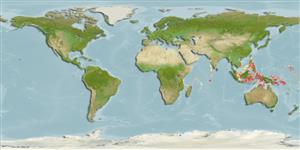>
Gobiiformes (Gobies) >
Gobiidae (Gobies) > Gobiinae
Etymology: Amblygobius: Greek, amblys = darkness + Latin gobius = gudgeon (Ref. 45335).
More on author: Herre.
Environment: milieu / climate zone / depth range / distribution range
Ekologi
laut berasosiasi dengan karang; kisaran kedalaman 2 - 15 m (Ref. 90102). Tropical
Western Pacific: Papua New Guinea.
Size / Weight / umur
Maturity: Lm ? range ? - ? cm
Max length : 8.5 cm SL jantan/; (Ref. 48637)
deskripsi pendek
Kunci identifiaksi (pengenalan) | Morfologi | Morfometrik
Duri punggung (Keseluruhan (total)) : 6 - 7; duri punggung lunak (Keseluruhan (total)) : 14 - 15; Duri dubur: 1; Sirip dubur lunak: 16. Characterized by dull brownish to blue grey body color with distinctive dark spots on snout; presence of row of brownish streaks or spots behind eye; pair of brown streaks on gill cover and pectoral fin base; first and second dorsal fin equal in height; lanceolate caudal fin; longitudinal scale series 65-75; fully scaled predorsal region; scales dorsally on opercle, absent on cheek; ctenoid scales on body; cycloid scales on nape, abdomen, and opercle; depth of body 5.0-5.4 in SL (Ref. 90102).
Usually paired (Ref. 90102). Inhabits silty sand of shallow protected inner reefs and intertidal flats near mangroves (Ref. 37816). Also occurs on muddy substrates to about 10 meters depth (Ref. 48637).
Life cycle and mating behavior
Maturities | Reproduksi, perkembang biakan | Spawnings | Egg(s) | Fecundities | Larva
Kailola, P.J., 1991. The fishes of Papua New Guinea: a revised and annotated checklist. Vol. III. Gobiidae to Molidae. Research Bulletin No. 41, Research Section, Dept. of Fisheries and Marine Resources, Papua New Guinea. 153 p. (Ref. 6771)
Status IUCN Red List (Ref. 130435)
ancaman kepada manusia
Harmless
penggunaan manusia
Alat, peralatan
laporan khas
muat turun XML
Sumber internet
Estimates based on models
Preferred temperature (Ref.
123201): 28.2 - 29.3, mean 28.8 °C (based on 666 cells).
Phylogenetic diversity index (Ref.
82804): PD
50 = 0.5000 [Uniqueness, from 0.5 = low to 2.0 = high].
Bayesian length-weight: a=0.00708 (0.00333 - 0.01504), b=3.09 (2.92 - 3.26), in cm total length, based on LWR estimates for this (Sub)family-body shape (Ref.
93245).
Trophic level (Ref.
69278): 3.0 ±0.2 se; based on size and trophs of closest relatives
Daya lenting (Ref.
120179): Tinggi, Waktu penggandaan populasi minimum kurang dari 15 bulan (Preliminary K or Fecundity.).
Fishing Vulnerability (Ref.
59153): Low vulnerability (10 of 100).
